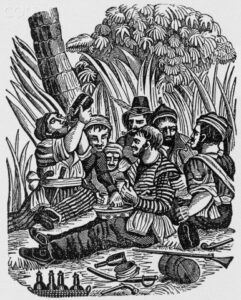When our Malabar &Cumballa Hills were jungles, with tigers, hyenas, jackals, snakes &other crawling creatures. When pirates guarded our coasts from ‘foreign traders’. When all our sins could be wiped out by going through a hole in a stone.

Till the end of 19th
Century that’s what we were – a forest on
the western hills of the largest of the seven islands.It was reported in the Bombay Courier dated February 10, 1822that
‘on February 9, 1822, a tiger on Malabar Hill came down and quenched its thirst
at Gowalia Tank and ran off up the hill between Hermitage and Prospect Lodge.
The imprint of its feet were clearly visible the next morning.’ Bombay Times reported on March 6, 1858
about a tiger ‘that attempted to board a small boat and was kept off with hand
pikes by the lascars’.
The hills and forests provided natural harbour for pirates, who attacked commercial sea vessels from the 15th to the 17th Centuries. The pirates, who plied their small vessels between lagoons and narrow waters between the islands, would attack the ‘foreign ships laden to the brim with the riches of India’; inflict heavy damage and get back into the safety of the shallow waters. These attackers were originally Kunhalis&Marrikars, running trade routes (mainly food grains) with the blessings of the King of Cochin and the Zamorin of Calicut. They were called ‘Malabari Pirates’ by the Portuguese, Dutch and the English, whose vessels were attacked between Bombay and Cape Comorin.Later they were joined by theSajanian pirates of Kathiawar, the Marathas and even the Portuguese to stop the ships of the East India Company, but the name stayed on. The peak that was used as a lookout point was called ‘Malabar Point’and the hillock that sheltered them from the open seas became ‘Malabar Hill.’
The original name of Malabar Hill was ‘Shrigundi’, meaning the Lucky Stone. At the very end of the Hill was a rock with a cleft in it, fancied as a ‘yoni’ by the numerous pilgrims who came for a dip in the Banganga Tank. They came for the purpose of regeneration and believed that if one could pass through this sacred emblem ‘with hands in front’, their sins could be wiped out and they could ascend the steps to heaven ‘with head first up’. A myth for sure!
Today Malabar Hill stands as home to SOBO snobs; the forests have given way to structures of cement and glass; the four-legged animals have been replacedby a different breed of two-legged ones; the ‘pirates’ still take shelter amidst the rocks; and the Lucky Stone was broken to build A-one Apartments outside the Raj Bhavan gates. Can the myth protect us all even today?
Anita Garware , Chairperson, INDIAN HERITAGE SOCIETY MUMBAI, Resident of Malabar Hill





